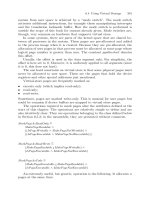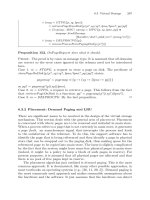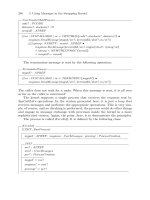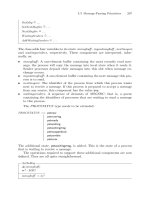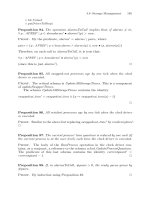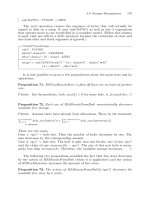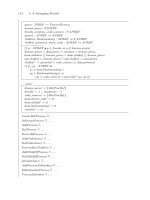Formal Models of Operating System Kernels phần 7 doc
Bạn đang xem bản rút gọn của tài liệu. Xem và tải ngay bản đầy đủ của tài liệu tại đây (250.21 KB, 29 trang )
5.3 Message-Passing Primitives 207
OutMsg =
SetNextMsgSrc =
NextMsgSrc =
WaitingSenders =
AddWaitingSenders =
The class adds four variables to its state: inmsgbuff , myoutmsgbuff , nextmsgsrc
and waitingsenders, respectively. These components are interpreted, infor-
mally, as:
• inmsgbuff : A one-element buffer containing the most recently read mes-
sage; the process will copy the message into local store when it reads it.
Sender processes deposit their messages into this slot when message ex-
change occurs.
• myoutmsgbuff : A one-element buffer containing the next message this pro-
cess is to send.
• nextmsgsrc: The identifier of the process from which this process wants
next to receive a message. If this process is prepared to accept a message
from any source, this component has the value any.
• waitingsenders: A sequence of elements of MSGSRC; that is, a queue
containing the identifiers of processes that are waiting to send a message
to this process.
The PROCSTATUS type needs to be extended:
PROCSTATUS ::= pstnew
| pstrunning
| pstready
| pstwaiting
| pstwaitingmsg
| pstswappedout
| pstzombie
| pstterm
The additional state, pstwaitingmsg, is added. This is the state of a process
that is waiting to receive a message.
The operations required to support these additional components are now
defined. They are all quite straightforward.
SetInMsg
∆(inmsgbuff )
m?:MSG
inmsgbuff
= m?
208 5 Using Messages in the Swapping Kernel
This operation is to be executed when a sending process synchronises with
this process. By setting inmsgbuff to a message, this process has received the
message.
The receiving process executes the InMsg operation when it wants to read
the current message.
InMsg
m!:MSG
m!=inmsg
A sending process places the message it is trying to send in this compo-
nent of its process table. This component represents a standard location for
outbound messages; it is copied by the primitives to the inmsgbuff component
of the receiver when the message is sent.
SetOutMsg
∆(outmsgbuff )
m?:MSG
outmsgbuff
= m?
The following operation retrieves the contents of the outmsgbuff compo-
nent of the process descriptor.
OutMsg
m!:MSG
m!=outmsgbuff
This operation is called by a process when it advertises the identifier of
the next process from which it wishes to receive a message. If the process is
willing to accept a message from any process or ISR, it supplies the value
any. If the process wishes to receive from some piece of hardware, it supplies
the value hardware (in general, a process will receive only from one piece of
hardware, e.g., the clock or a disk driver).
SetNextMsgSrc
msrc?:MSGSRC
nextmsgsrc
= msrc?
This operation retrieves the value stored in nextmsgsrc.Thisisusedto
determine which process to resume when waitingsenders is not empty.
NextMsgSrc
msrc!:MSGSRC
msrc!=nextmsgsrc
5.3 Message-Passing Primitives 209
As indicated before the schema, a search is made when waitingsenders is non-
empty to determine whether a process is to send its message to this process.
This operation returns the queue of the identifiers of those processes wait-
ing to send a message to this process.
WaitingSenders
sndrs!:seqMSGSRC
waitingsenders = sndrs!
When a process is sending a message to this process and this process is
unable to accept it, the sender is enqueued here.
AddWaitingSenders
∆(waitingsenders)
sndr?:MSGSRC
waitingsenders
= waitingsenders
sndr?
The ProcessTable is also the same except for some minor additions. As with
the ProcessDescr class, the class is presented below in outline form only and
shows only those components that are required to support message passing.
The rest of the definition can be found in Section 4.4 of Chapter 4.
The differences between the ProcessTable required by the previous ker-
nel and the present one consist in two operations—MessageForDriver and
AddDriverMessage, which manipulate messages whose destination is a driver
process—and in a new table, drivermsgs, which maps the identifier of the
destination process (which should be the identifier of a driver process) to the
next message it is intended to receive.
ProcessTable
(INIT ,
MessageForDriver ,
AddDriverMessage)
drivermsgs : APREF → MSG
(∀ p : APREF | p ∈ dom drivermsgs •
(∃ pd : ProcessDescr; k : PROCESSKIND •
DescrOfProcess[p/pid?, pd /pd !]
∧ pd .ProcessKind[k/knd!]
∧ k = ptdevproc))
210 5 Using Messages in the Swapping Kernel
INIT
dom drivermsgs
= ∅
MessageForDriver =
AddDriverMessage =
Messages for drivers are handled slightly differently. The support for them
is provided by the following pair of operations.
MessageForDriver
pid?:APREF
dmsg!:MSG
dmsg!=drivermsgs(pid?)
AddDriverMessage
∆(drivermsgs)
pid?:APREF
dmsg?:MSG
drivermsgs
= drivermsgs ⊕{pid? → dmsg?}
Driver messages must be treated differently because the driver might be
busy when the message is sent. Messages to drivers are of high priority and
must be delivered. Therefore, any messages with a driver as destination are
temporarily stored if the driver cannot immediately receive them.
There is a generic message-based ISR that responds to interrupts by cre-
ating and sending messages from hardware.
Process context manipulation must be redefined to account for messages.
This is an interrupt-driven kernel, so the context switch is a logical place to
insert message-handling code.
The Context structure is the same as that defined in the last chapter.
It is repeated here because it plays a central role in the modelling of the
message-passing subsystem. The class is
Context
(INIT , SaveState, RestoreState,
SwapOut, SwapIn, SwitchContext)
ptab : ProcessTable
sched : LowLevelScheduler
hw : HardwareRegisters
5.3 Message-Passing Primitives 211
INIT
ptb?:ProcessTable
shd?:LowLevelScheduler
hwregs?:HardwareRegisters
ptab
= ProcessTable
sched
= LowLevelScheduler
hw
= hwregs?
SaveState =
RestoreState =
SwapOut =
SwapIn =
SwitchContext =
The SaveState operation’s schema is very much as in the previous kernel.
Since it is relatively short, it is repeated here.
The SaveState and RestoreState operations are intended to be called from
within an ISR. The SaveState stores the contents of the hardware register in
the descriptor of the process referred to by currentp. The scheduler, just like
the one in Chapter 4, can then be called to select another process to execute
(if there are none, the idle process is run); as a part of this selection operation,
currentp becomes bound to the identifier of the selected process. At the end,
RestoreState should be called to copy the newly selected process’ state to the
hardware.
SaveState
(∃ cp : IPREF •
sched.CurrentProcess[cp/cp!]
(∃ pd : ProcessDescr •
ptab.DescrOfProcess[cp/pid?, pd /pd !]
∧ (∃ regs : GENREGSET; stk : PSTACK;
ip : N; stat : STATUSWD; tq : TIME •
hw.GetGPRegs[regs/regs !] ∧ hw.GetStackReg[stk/stk!]
∧ hw.GetIP[ip/ip!] ∧ hw.GetStatWd[stat/stwd!]
∧ sched.GetTimeQuantum[tq/tquant!]
∧ pd .SetFullContext[regs/pregs?, ip/pip?,
stat/pstatwd?, stk/pstack?, tq/ptq?])))
The current process referred to in the following schema is not necessarily
the same as the one referred to in the previous schema. Basically, whichever
process is referred to by currentp is the next to run and its context is switched
onto the processor. It should be noticed that the instruction pointer is the last
212 5 Using Messages in the Swapping Kernel
register to be set. This is because it hands the processor to the process that
owns it.
RestoreState
(∃ cp : IPREF •
sched.CurrentProcess[cp/cp!]
∧ (∃ pd : ProcessDescr •
ptab.DescrOfProcess[cp/pid?, pd /pd !]
∧ (∃ regs : GENREGSET; stk : PSTACK; ip : N;
stat : STATUSWD; tq : TIME •
pd .FullContext[regs /pregs!, ip/pip!, stat/pstatwd!,
stk/pstack!, tq/ptq!]
∧ hw.SetGPRegs[regs/regs ?]
∧ hw.SetStackReg[stk/stk?]
∧ hw.SetStatWd[stat/stwd?]
∧ sched.SetTimeQuantum[tq/tquant?]
∧ hw.SetIP[ip/ip?])))
The general operation for swapping out a context is defined by the next
operation:
SwapOut
=
(∃ cp : IPREF ; pd : ProcessDescr •
sched.CurrentProcess[cp/cp!]
∧ ptab.DescrOfProcess[pd /pd !]
∧ pd .SetProcessStatusToWaiting
∧ SaveState
o
9
sched.MakeUnready[currentp/pid?])
The operation calls SaveState and then unreadies the process referred to by
currentp.
Similarly, SwapIn is the general interface to the operation that swaps a
context onto the processor.
SwapIn =
(∃ cp : IPREF ; pd : ProcessDescr •
sched.CurrentProcess[cp/cp!]
∧ pd .SetProcessStatusToRunning
RestoreState)
SwitchContext
= SwapOut
o
9
SwapIn
The low-level scheduler is identical to the one defined in the last chapter
(Section 4.5).
This kernel requires a global variable to store clock ticks that might have
been missed by drivers that are not waiting when the clock interrupt arrives.
This variable is not protected by a lock. It is assumed that there is no need
5.3 Message-Passing Primitives 213
because it can only be accessed and updated under strict conditions (there can
be no other process active when update and read occur—this is guaranteed by
the fact that this kernel executes on a uni-processor; if the kernel were ported
to a multi-processor, matters might be a little different).
GlobalVariables
(INIT , missed
ticks)
missed ticks : N
INIT
missed ticks
=0
Finally, we come to the core of the model of message passing. This is the
generic ISR that sends messages to devices to wake them up. This is the most
detailed specification of an ISR that has been given so far in this book. The
reason for this is that it is central to the operation of the message-passing
mechanism.
The generic ISR is modelled by the GenericMsgISR classasfollows:
GenericMsgISR
(INIT , SendInterruptMsg)
did : APREF
mm : MsgMgr
ctxt : Context
busydds : F APREF
glovars : GlobalVariables
INIT
isrname?:APREF
msgmgr?:MsgMgr
ctxtops?:Context
gvs?:GlobalVariables
ctxt
= ctxtops?
did
= isrname?
mm
= msgmgr?
busydds
= ∅
glovars
= gvs?
saveState
=
restoreState =
shouldRunDriver =
SendInterruptMsg =
214 5 Using Messages in the Swapping Kernel
Before discussing the more interesting points about this ISR, it is worth
pointing out that this model, like the others in this book, makes only minimal
assumptions about the hardware on which the kernel runs. In particular, it
is assumed that ISRs do not dump the hardware registers anywhere when an
interrupt occurs. It is merely assumed that, when the interrupt does occur,
a context will be current; that context is the interrupted one. It is also the
context that might be switched out, should the scheduler so determine.
It is worth remembering that the interrupt mechanisms of any particular
processor could differ considerably from this one; it is a reliable assumption
that the contents of currentp will be unaffected by any interrupt. Where the
context is deposited by a particular cpu is a detail that cannot be accounted
for by this model. In what follows, it should be assumed that the state save
and restore operations are able to locate the registers belonging to the current
process; that is, to the process referred to by currentp.
saveState = ctxt.SaveState
This operation saves the current context in the descriptor of the process re-
ferred to by currentp when the interrupt occurs.
restoreState
= ctxt.RestoreState
This is the operation that installs a context in the cpu. The process might be
different from the one current when the interrupt occurred.
shouldRunDriver
= sched.IsEmptyDriverQueue ∧ sched.IdleIsCurrent
This operation forces the execution of the driver associated with this ISR if
the scheduler’s queues are empty and the idle process is currently running.
The driver will always have a higher priority than the idle process, so the net
effect of this operation is to pre-empt the idle process’ execution. It is called
from the next operation.
The usual form of an ISR using messages is:
(* Current process is running. *)
SaveState
o
9
(* Do some processing and create message. *)
SendInterruptMsg
o
9
(* A new process might be in currentp. *)
RestoreState
(* Possible new process executing. *)
The following operation sends a message to a process when the interrupt
occurs. The process will usually be the driver associated with the interrupt.
At the end of the operation, the shouldRunDriver operation is executed,
followed by a call to the scheduler.
5.3 Message-Passing Primitives 215
There is one more operation defined in the class. It is the one defined
next. This operation sends messages generated by ISRs. These messages are
used to wake the driver process that corresponds to a driver. The problem is
that the driver might have been interrupted or could even be blocked when
the message is to be sent. For that reason, the schema records the identifier
of the destination driver when it is busy. In addition, the operation is used
by the clock ISR to send a message to the clock process. Given the above,
it is possible that some clock ticks might be missed, so each invocation of
the SendInterruptMsg operation adds 1 to a “missed tick” counter (called
missed
ticks and defined in the global variables class, GlobalVariables, defined
immediately before the GenericMsgISR class).
SendInterruptMsg
∆(missedclicks, busydds)
driver?:APREF
m?:MSG
(∃ dpd : ProcessDescr •
ptab.DescrOfProcess[did/pid?, dpd/pd !]
∧ (¬ mm.IsWaitingToReceive[dpd/pd ?]
∧ ((driver?=CLOCKISR
∧ glovars.missed ticks
= glovars.missed ticks +1)
∨ (busydds
= busydds ∪{driver?}
∧ ptab.AddDriverMessage[driver?/pid ?, m?/dmsg?]))))
∧ (∀ p : APREF | p ∈ busydds •
(∃ pd : ProcessDescr •
∧ ptab.DescrOfProcess[p/pid?, pd /pd !]
∧ (mm.IsWaitingToReceive[pd /pd ?]
∧ (∃ hwid : MSGSRC | hwid = hardware •
∧ msgmgr.SendMessage[hwid/src?, p/dest?])))
⇒ p ∈ busydds
)
∧ (shouldRunDriver ∧ sched.ScheduleNext)
We are now in a position to prove some fairly general properties of the
message-passing system.
Proposition 112. The message-passing mechanism is synchronous.
Proof. By the predicates of SendMessage and RcvMessage.
If the destination is already waiting when the source sends a message, the
message is immediately received. Otherwise, the destination eventually enters
a waiting state, during which the message is exchanged. ✷
Proposition 113. Unless the destination process terminates (or the system
is shut down), every message is delivered to its destination.
216 5 Using Messages in the Swapping Kernel
Proof. There are two cases to consider.
Case 1. If the destination is waiting to receive from either the sender or any
process (IsWaitingToReceive), the message is immediately copied to the des-
tination (SetInMsg). The sender is the current process and continues. The
message has been delivered.
Case 2. If the destination is not waiting, or waiting for a message from a
source other than the current process or the default source, any, the sender is
enqueued onto the destination’s queue (list) of processes that are waiting to
send a message to it; the sender is unreadied so that it cannot be scheduled.
When the destination is ready to receive a message, it selects a process
from its waiting list and adds it to the ready queue after the message has been
copied from the sender to the destination.
A receivers can specify the source of the message it wants to recevie next
(this is the sender’s process identifier) or the special value any.Ifany is
specified, the receiver is willing to accept a message from any process that
wishes to send to it.
Provided that the receiver lives long enough and provided that the receiver
issues enough requests for any sender, all of the messages sent to the receiver
are received. ✷
Proposition 114. Every device process receives its interrupt messages in the
correct order.
Proof. This follows from the previous result. The difference is that In-
terrupt Service Routines (ISRs) are not processes and cannot, therefore, be
suspended. If the associated driver process is not yet ready to receive from
the ISR, the message is stored in a special location until it can be delivered
when a subsequent interrupt occurs. ✷
Proposition 115. Every message sent is received in the correct order.
Proof. This follows from the behaviour of synchronous messages. Consider
two processes, S and D. Each time S sends a message, m,toD,eitherS
is suspended or the message is delivered; when S is resumed, the message
is delivered. If S sends two messages to D,saym
1
and m
2
,inthatorder,
then S first attempts to send m
1
.IfD is waiting to receive, the message is
delivered and S continues; if D is not waiting to receive, S is suspended until
D is ready. In either case, message m
1
is delivered. Next, S tries to send m
2
and goes through the same sequence of operations and state transitions; m
2
is delivered, however. The order in which the messages are delivered is m
1
followed by m
2
. By induction, the order in which messages are received is the
same as the order in which they are sent. ✷
5.3 Message-Passing Primitives 217
Proposition 116. Nothing happens in the system unless an interrupt occurs.
Proof. The critical part of this is: when do context switches occur?
In this kernel, a context switch occurs in the general ISR code. (In the
previous kernel, context switches occurred in ISR code and in the semaphore’s
Wait operation.)
When the generic ISR code runs, the actual context changes. First, the
register set is switched out; these registers belong to the process named by
thecurrentvalueofcurrentp. The scheduler then executes and changes the
value of currentp; there can be more than one scheduling decision in this ker-
nel before the ISR exits, but the important fact is that these intermediate
scheduling decisions do not affect the context. Indeed, only the last schedul-
ing decision (assignment to currentp) occurring before the ISR terminates is
switched onto the processor.
Since context switches change the state of the system and cause differ-
ent processes to execute, and since context switches occur only in ISRs, the
proposition has been proved. ✷
Proposition 117. Each interrupt causes a context switch. This alters the
currently running process.
Proof. The reasoning is similar to that of the previous proposition. ✷
Finally, there are the operations to support message passing at the level
of the process. They are collected into the following object (module). This
is really more a matter of convenience than of anything else. The module is
called MsgMgr,theMessage Manager.
As far as processes are concerned, this module contains the most important
operations. It is also a relatively complex module whose workings are, at first
sight, somewhat obscure. Because of this, the operations defined below are
described (perhaps painfully) in more detail.
MsgMgr
(INIT , IsWaitingToReceive, SendMessage, RcvMessage)
ptab : ProcessTable
sched : LowLevelScheduler
INIT
pt?:ProcessTable
schd?:LowLevelScheduler
ptab
= pt?
sched
= schd?
218 5 Using Messages in the Swapping Kernel
IsWaitingToReceive =
SendMessage =
RcvMessage =
isWaitingForSender =
enqueueSender =
canReady =
haveMsgsWithAppropriateSrc =
copyMessageToDest =
RcvMessage =
It must be remembered that the operations defined by the MsgMgr class
are always called from inside an ISR. This has implications for the use of
context switches and the identity of callers and destinations.
IsWaitingToReceive
pd ?:ProcessDescr
(∃ stat : PROCSTATUS; wtgfor : PROCWAITINGON •
pd .ProcessStatus[stat/st!]
∧ stat = pstwaitingmsg)
isWaitingForSender
pd ?:ProcessDescr
sender?:APREF
(∃ nxtsrc : MSGSRC •
pd ?.NextMsgSrc[nxtsrc/msrc!]
∧ (nxtsrc = any ∨ nxtsrc = sender?))
enqueueSender
pd ?:ProcessDescr
sender?:APREF
pd ?.addWaitingSender[sender?/sndr ?]
If a receiver is waiting for a message from a process and that process is
not in its waiters queue, it will be placed in “limbo”, i.e., removed from all
queues. When the message eventually arrives, it is put onto its ready queue
by SendMessage.
5.3 Message-Passing Primitives 219
SendMessage
dest?, src?:APREF
m?:MSG
(∃ pd : ProcessDescr •
ptab.DescrOfProcess[dest?/pid?, pd /pd !]
(∃ stat : PROCSTATUS; wtgfor : PROCWAITINGON •
pd .ProcessStatus[stat/st!]
∧ ((IsWaitingToReceive[pd /pd ?]
∧ isWaitingForSender
∧ pd .SetInMsg
∧ sched.MakeReady[dest?/pid?])
∨ ((pd .addWaitingSender[pd /pd ?, src?/sender?]
∧ sched.MakeUnready[src?/pid?])))))
The next operation to be defined determines whether the process described
by the process descriptor bound to pd ?canbemovedtoapstready state.
canReady
pd ?:ProcessDescr
(∃ stat : PROCSTATUS •
pd ?.ProcessStatus[stat/st!]
∧ (stat = pstterm
stat = zombie))
haveMsgsWithAppropriateSrc
pd ?:ProcessDescr
src?:MSGSRC
(∃ waiters :seqAPREF •
pd ?.WaitingSenders[waiters/sndrs!]
∧ waiters =
∧ src? ∈ ran waiters)
copyMessageToDest
cpd?, spd?:ProcessDescr
(∃ m : MSG •
spd?.OutMsg[m/m!]
∧ cpd?.SetInMsg[m/m?])
Note that if the receiver doesn’t have any appropriate senders, it is removed
from all queues.
220 5 Using Messages in the Swapping Kernel
RcvMessage
caller ?:APREF
src?:APREF
m!:MSG
(∃ cpd : ProcessDescr •
ptab.DescrOfProcess[caller?/pid?, cpd/pd !]
∧ (∃ waiters :seqAPREF •
cpd.WaitingSenders[waiters/sndrs!]
∧ ((haveMsgsWithAppropriateSrc
∧ (∀ p : APREF | p ∈ ran waiters •
(∃ spd : ProcessDescr •
ptab.DescrOfProcess[p/pid?, spd/pd !]
∧ (src?=any ∨ src?=caller ?
∧ copyMessageToDest[cpd/cpd?, spd/spd?]
∧ ((canReady [spd/pd ?] ∧ MakeReady[p/pid?])
∨ Skip)))))
∨ sched.ScheduleNext)))
The operations defined in this class are not designed to be executed di-
rectly. It is intended that they be executed by raising an interrupt. Therefore,
any user process must raise an interrupt to send a message and raise another
to read a message. When sending the message, the ISR has to retrieve the
message and the destination address from somewhere (say, some fixed offset
from the top of the calling process’ stack). In a similar fashion, when a process
performs a receive operation, the parameters must be in a standard location.
In order to make this clear (and to permit the proof of one or two relevant
propositions), the two interrupt-handling classes are defined, one each for send
and receive. The reader should be aware that they are only defined in outline
(this is, in any case, in line with our general policy on hardware matters). In
order to define them, it will be necessary to assume an operation:
RaiseInterrupt
ino?:N
This can be assumed to be a hardware operation (i.e., it can be modelled
as an operation provided by the HardwareRegisters class. The input to the
operation, ino?, is the number of the interrupt.
Both classes are subclasses of GenericISR,thuspermittingthesaveand
restore operations on contexts.
The first class is the one that implements the interface for sending mes-
sages. Its main operation, ServiceInterrupt handles the message by calling the
SendMessage operation defined in the MsgMgr class.
5.3 Message-Passing Primitives 221
SendISR
(INIT , ServiceInterrupt)
GenericISR
mmgr : MsgMgr
sched : LowLevelScheduler
INIT
mm?:MsgMgr
sch?:LowLevelScheduler
mmgr
= mm?
sched
= sch?
ServiceInterrupt =
∧ sched.CurrentProcess[mypid/cp!]
∧ mmgr.SendMessage[mypid/src?, ]
The second class is the one that implements the interface for receiving mes-
sages. Its main operation, ServiceInterrupt, handles the message by calling the
RcvMessage operation defined in the MsgMgr class. When a process is ready
to receive a message, it raises an interrupt, thus invoking the ServiceInterrupt
operation.
ReceiveISR
(INIT , ServiceInterrupt)
GenericISR
mmgr : MsgMgr
INIT
mm?:MsgMgr
mmgr
= mm?
ServiceInterrupt
=
∧ sched.CurrentProcess[mypid/cp!]
∧ mmgr.RcvMessage[mypid/caller ?, ]
It will be assumed that there is a mechanism by which kernel processes
can send and receive messages. Rather than performing a full system call, this
222 5 Using Messages in the Swapping Kernel
alternative mechanism will be used (it still performs a RaiseInterrupt). It will
be denoted by KMsgMgr.
Proposition 118. The sender of a message is always the current process.
Proof. In order to send a message, the sending process must execute a
call that involves RaiseInterrupt in order to raise the interrupt associated
with message sending. However, the only process that can do this is the one
currently referenced by currentp since it denotes the only executing process
at any time.
Furthermore, the sender, src?, for the message to be sent is bound to the
value of currentp by sched.CurrentProcess. ✷
Proposition 119. The receiver of a message is always the current process.
Proof. By reasoning similar to the first paragraph of the previous proposi-
tion (the caller can be the only executing process on a uni-processor machine).
In this case, the caller ? of the receive operation, mmgr.RcvMessage,is
bound to the value of currentp by sched.CurrentProcess. ✷
Proposition 120. If a sending process is not one for which the destination
is waiting, the sender is removed from the ready queue.
Proof. The relevent class is MsgMgr and the relevant operation is, clearly,
SendMessage. The second disjunct of SendMessage’s predicate is as follows:
(¬ isWaitingToReceive[pd /pd ?]
∨¬isWaitingForSender )
∧ pd .addWaitingSender[pd /pd ?, src?/sender?]
∧ sched.MakeUnready[src?/pid?]
This conjunct deals with the case in which the destination is either not in
the special waiting-for-message state or it is not waiting to receive from the
current process (that is, the process referred to by currentp). As can be seen,
the sender is made unready by the second conjunct. This removes it from the
head of the ready queue so that it cannot be rescheduled until the receiver is
ready for it. ✷
Corollary 9. The sending process is always referred to by currentp.
Proof. By Proposition 118. ✷
Proposition 121. When a process, d, receives a message, m, from a process,
s, m is placed into d’s incoming message slot.
5.3 Message-Passing Primitives 223
Proof. The significant line of mmgr.RcvMessage is copyMessageToDest[ ],
which expands into:
∃ m : MSG •
spd?.OutMsg[m/m!]
∧ cpd?.SetInMsg[m/m?]
where both cpd ?andspd are process descriptors. With one more level of
expansion and simplification, this becomes:
cpd.inmsgbuff
= spd?.outmsgbuff
This is clearly the operation required in the statement of the proposition. ✷
Proposition 122. If a process, d, is waiting for a message from any process
and there is a waiting sending process, s, the process s will be readied.
Proof. By the predicate of mmgr.RcvMessage, having copied the message
over, if the waiting process can be readied, it is placed in the ready queue by
MakeReady:
copyMessageToDest
∧ ((canReady [spd/pd ?] ∧ MakeReady[p/pid?]
where spd is the process descriptor of the message source (sender process
descriptor) and p is its process identifier. ✷
It is necessary to make message passing easier to use in user-level processes.
In support of this, a new class is defined. This new class, called UserMessages,
exports two operations, Send and Receive . The exported operations are in-
tended to place the parameters required by the send and receive operations
in an easily accessible place and raises the necessary interrupts. The class is
defined in outline as:
UserMessages
(INIT , Send, Receive )
sendintno, recvintno : N
INIT
sendno?, recvno?:N
sendintno
= sendno?
recvintno
= recvno?
raiseSendInterrupt
= RaiseInterrupt[sendintno/intno?, ]
raiseRcvInterrupt = RaiseInterrupt[recvintno/recvno?, ]
Send = raiseSendInterrupt[m?/msg?, ]
Receive = raiseRcvInterrupt[m!/msg!, ]
224 5 Using Messages in the Swapping Kernel
This definition is intended merely to give the reader an idea of what it should
look like. The state variables, sendinto and recvintno, denote the number
of the send and receive interrupts, respectively. The second argument to the
message-passing operations is the message being sent or received, respectively.
In both cases, there will be other parameters (e.g., for receiving, the origin of
the message can be specified).
The UserMessages class will be instantiated once in the kernel interface
library.
Before moving on, it is worth pausing to reflect at a high level on what
has been presented so far. The reader should note that the above model is
not the only one. The Xinu operating system [9] is also based on message
passing but does not integrate messages with interrupts and is, therefore, in
our opinion, a somewhat cleaner kernel design. However, many readers will, as
a result of reading standard texts, be of the (false) opinion that kernels must
be interrupt-driven. The kernel of the last chapter was driven, in part, by in-
terrupts and, in part, by semaphores (recall that semaphores cause a context
switch and a reschedule); many real-time kernels are also driven only partially
by interrupts. Nevertheless, many kernels are organised entirely around inter-
rupts. This approach has merits (uniformity and simplicity) when there are
interactive users hammering away at keyboards and torturing hapless mice!
The current kernel was intended to show how such kernels can be structured,
even if that structure becomes somewhat opaque in places; it is not intended
as a statement that this is how they must be organised. (For a completely
different approach, Wirth et al.’s fascinating and elegant Oberon system
[35, 36] is recommended).
With these points noted, it is possible to move on to the use of the message-
passing subsystem as defined above. The reader will be relieved to learn that
what follows is far less convoluted than that which has gone before. Indeed, it
is believed that the following models are cleaner and easier to construct and
understand than those defined using semaphores.
5.4 Drivers Using Messages
In this section, the semaphore-based drivers from the swapping kernel are
presented in an altered form: they now use message passing. Because of its
centrality, the clock is the first to be considered. This will be followed by the
swapper process, a process that turned out to be quite complex when defined
in the last chapter.
Because these driver processes have already been presented in detail in the
last chapter, it is only necessary to cover those parts that differ as a result of
the use of message passing. This will allow us to ignore the common parts,
thus simplifying the exposition.
5.4 Drivers Using Messages 225
5.4.1 The Clock
To begin the discussion, the constant ticklength is repeated. It is the amount
of time represented by a single tick of the clock:
ticklength : TIME
Next, a message type is defined:
CLOCKMSG ::= CLKTICK TIME
CLOCKISR
(INIT , ServiceISR)
GenericISR
time : TIME
msgs : KMsgMgr
INIT
tm?:TIME
msgman?:MsgMgr
msgs
= msgman?time
= tm?
ServiceISR =
time
= time + ticklength
o
9
(∃ dest : APREF; m : CLOCKMSG |
dest = clock ∧ m = CLOCKTICK time •
SendInterruptMsg[dest/driver?, m/m?])
Although logically correct, there are pragmatic issues that need to be
discussed. There are similar issues with the page-fault mechanism, which is
addressed in some detail in the next chapter. Meanwhile, the clock driver
process is presented.
The process is essentially the same as the one specified in the last chapter
(Section 4.6.3). The difference, of course, is that the process uses message
passing to communicate the current time and to record requests for alarms.
Alarms themselves are implemented in the same way as in the last chapter.
In order to implement message passing, it is necessary to provide an inter-
face to the internal kernel message manager, KMsgMgr,totheclockdriver.
ClockDriver
(INIT , RunProcess)
226 5 Using Messages in the Swapping Kernel
swaptabs : ProcessStorageDescrs
msgman : KMsgMgr
lk : Lock
now : TIME
missing : TIME
alarms : APREF → TIME
INIT =
addAlarm =
cancelAlarm =
processRequests =
alarmsToCall =
updateSwapperTimes
=
getNextTick =
RunProcess =
The initialisation operation is basically the same as in the last chapter. It is
necessary, of course, to initialise the reference to the message manager.
The operation to inform the swapper process of the current time is now
implemented as a message-passing method. It is defined as follows:
updateSwapperTimes =
swaptabs.UpdateAllStorageTimes
o
9
(∃ src, dest : APREF; m : MSG | src = clock ∧ dest = swapper •
m = SWAPTIME now
∧ msgman.SendMessage[dest/dest?, src/src, m/m?])
The main point about this operation is that it now constructs a message of
type SWAPTIME that contains the current time as its payload. The destina-
tion to which the message is to be sent is the swapper process.
As noted above, the SendMessage operation is implicitly overloaded.
The clock driver obtains the current time from the hardware clock via the
clock ISR, which sends a CLKTICK message to the driver process. Sending
this message is the main point of the ISR.
It should be noted that the entire clock could be implemented within
the ISR. This would lead to an implementation that could place reasonable
guarantees on alarms and on the time displayed by the clock. The clock in this
model, as in the last, is really organised to display the various interactions
between components and how they can be modelled formally. For this reason,
the optimisation remark below is of importance.
The CLKTICK message contains the current time in an appropriate form
(probably in terms of milliseconds). The missed
ticks global variable is up-
dated just in case any drivers are unable to synchronise.
5.4 Drivers Using Messages 227
getNextTick
=
(∃ src, dest : APREF; cm : MSG; tm : TIME |
src = hardware ∧ dest = clock •
msgmgr.RcvMessage[src/src?, dest/dest?, cm/m!]
∧ cm = CLKTICK tm
∧ missing = glovars.missed
ticks
∧ now
= now + missed ticks + tm
∧ glovars.missed
ticks
= glovars.missed ticks − missing
This operation is another example of how the receiving process can request
the next message from a specific source, in this case from the clock (which
happens to be the clock ISR).
The main routine of this process is RunProcess. It implements an infinite
loop (modelled by quantification over an infinite domain). The main routine
is resumed when the ISR sends it a message containing the current time. The
routine then disables interrupts and sends a message to update the swapper’s
tables; it also updates the current process quantum (this is a shared variable
in the scheduler, so access needs to be locked). The driver then decodes other
messages. If the message is of type NULLCLKRQ, it checks the alarms that
it needs to call and readies the processes that are waiting for them. Because
readying waiting processes alters the scheduler’s queues, the scheduler is called
to select a process to run after the driver suspends. If the message is an alarm
request (denoted by a message of type AT ), the requesting process is added to
the alarm queue in the driver. Otherwise, the message is a NOTAT message;
this message type is used to cancel a previously requested alarm. In both
cases, processes waiting for alarms are readied and the scheduler is called.
Since these operations are within the scope of the universal quantifier, the
process then waits for the next message from the ISR.
RunProcess =
(∀ i :1 ∞•
(getNextTick
o
9
(lk.Lock
o
9
(ptab.UpdateCurrentProcessQuanta[now
/tm?]
∧ updateSwapperTimes[now /tm?] ∧ sched.UpdateProcessQuantum
∧ lk.Unlock)))
∨ ((rq ?=NULLCLKRQ ∧ alarmsToCall ∧ sched.ScheduleNext)
∨ ((rq ?=AT p, t ∧ addAlarm[p/p?, t/tm?])
∨ (rq ?=NOTAT p, t ∧ cancelAlarm[p/p?, t/tm?])
∧ alarmsToCall ∧ sched.ScheduleNext)))
The main routine is organised as a three-way branch, or as three disjuncts:
1. The first case handles messages from the clock ISR. This causes swapper
and quantum updates inside a lock.
2. The second case receives requests from processes needing an alarm.
3. The final case receives requests from processes wanting to cancel previ-
ously requested alarms.
228 5 Using Messages in the Swapping Kernel
This organisation imposes no priorities on the messages. It is essential for the
clock to be able to respond to ISR messages but it must also be available
to handle alarm requests and cancellations. If the process waited for clock
ticks and then waited for requests and cancellations, it would only be able
to respond to the latter when a clock tick had awakened the process. It is
expected that alarms (and cancellations) will be comparatively rare and that
the probability that they will occur at the same time as a clock tick is low. It
is also expected that the time taken to execute the clock driver is very much
less than the time between clock ticks (if this turns out to be false, the driver
can be optimised by splitting it into two processes).
5.5 Swapping Using Messages
In this section, the various processes implementing the swapping process are
presented in an altered form: they now use message passing.
The swapper processes defined in this chapter use message passing in-
stead of semaphores and shared variables. It is, therefore, necessary to define
message types.
The message types contain information required by the desired operation.
The request type (which is assumed to be a sub-type of MSG, so over-loading
is, again, implicit) is as follows:
SWAPRQMSG ::= NULLSWAP
| SWAPOUT PREF × ADDRESS × ADDRESS
| SWAPIN PREF × ADDRESS
| NEWSPROC PREF × RMEM
| DELSPROC PREF
An extra message type is required to replace the semaphore that indicated
that the image-copy operation has been completed (Section 4.6.1). Instead of
signalling on a semaphore, the disk process sends a message of the following
type to the swapper:
SDRPYMSG ::= DONE
SWAPDISKDriverProcess
(INIT , SwapDriver)
dmem : APREF → RMEM
sms : SharedMainStore
msgmgr : KMsgMgr
5.5 Swapping Using Messages 229
INIT
store?:SharedMainStore
mm?:KMsgMgr
dom dmem
= ∅
sms
= store?
msgmgr
= mm?
writeProcessStoreToDisk =
readProcessStoreFromDisk =
deleteProcessFromDisk =
handleRequest =
SwapDriver =
The SwapDriver operation is the main one of the process. It is defined as
an infinite loop whose body receives messages from swapdisk:
SwapDriver =
∀ i :1 ∞•
(∃ src, dest : APREF; rq : SWAPRQMSG |
src = swapper ∧ dest = swapdisk •
msgmgr.RcvMessage[src/src?, dest/dest?, rq/m!]
∧ (rq = NULLSWAP ∧ handleRequest
∧ (∃ SDRPYMSG •
msgmgr.SendMessage[dest/src?, src/dest?, rpy/m?])))
As is common with such processes, the real work is performed by an op-
eration that is not the main entry point. In this case, it is handleRequest:
handleRequest
rq ?:SWAPRQMSG
(∃ p : APREF ; start, end : ADDRESS ; mem : RMEM •
rq ?=SWAPOUT p, start, end
∧ sms.CopyMainStore[start/start?, end/end?, mem/mseg!]
∧ writeProcessStoreToDisk[p/p?, mem/ms?])
∨ (∃ p : APREF ; ldpt : ADDRESS; mem : RMEM •
rq ?=SWAPIN p, ldpt
∧ readProcessStoreFromDisk[p/p?, mem/ms!]
∧ sms.WriteMainStore[ldpt/loadpoint?, mem/mseg?])
∨ (∃ p : APREF •
rq ?=DELSPROC p ∧ deleteProcessFromDisk [p/p?])
∨ (∃ p : APREF ; img : RMEM •
rq ?=NEWSPROC p, img
∧ writeProcessStoreToDisk[p/p?, img/img?])
230 5 Using Messages in the Swapping Kernel
The operation uses the type of the latest message to determine which action to
take (dispatches, that is, according to message type). Its definition is similar
to that in the previous chapter.
The swapper process is now as follows:
SwapperProcess
(INIT , SwapperProcess)
pdescrs : ProcessStorageDescrs
proctab : ProcessTable
sms : SharedMainStore
hw : HardwareRegisters
realmem : SharedMainStore
msgmgr : KMemMgr
INIT =
requestWriteoutSegment =
requestReadinSegment =
SwapperProcess =
SwapProcessOut =
SwapCandidateOut =
SwapProcessIn
=
SwapProcessIntoStore =
DoDiskSwap =
The operations of this process are similar to those in the semaphore-based
one. The primary difference is that messages are used instead of the semaphore
andsharedvariable.
The following operation is dispatched when a SWAPRQMSG is received.
It sends a SWAPOUT message to the swap-disk process and waits for the
SDRPYMSG to synchronise.
requestWriteoutSegment
p?:APREF
start?, end?:ADDRESS
(∃ rq : SWAPRQMSG; src, dest : APREF |
src = swapper ∧ dest = swapdisk •
rq = SWAPOUT p?, start?, end?
∧ msgmgr.SendMessage[src/src?, dest/dest?, rq/m?]
∧ (∃ rpy : SDRPYMSG •
msgmgr.RcvMessage[dest/src?, src/dest?, rpy/m!]
∧ rpy = DONE ))
5.6 Kernel Interface 231
Operation requestReadinSegment is, again, a message-dispatched one that
sends a message to the swap-disk process.
requestReadinSegment
p?:APREF
loadpoint?:ADDRESS
(∃ rq : SWAPRQMSG; src, dest : APREF |
src = swapper ∧ dest = swapdisk •
rq = SWAPIN p?, loadpoint?
∧ msgmgr.SendMessage[src/src?, dest/dest?, rq/m?]
∧ (∃ rpy : SDRPYMSG •
msgmgr.RcvMessage[dest/src?, src/dest?, rpy/m!]
∧ rpy = DONE ))
This operation, like the previous one, shows how much can be done just by
exchanging messages. It also demonstrates how much clearer message-based
code is than that based on semaphores.
The final operation of this subsection is the main one of the process. It
loops forever waiting for messages to arrive. It then calls DoDiskSwap to do
the real work.
SwapperProcess
=
∀ i :1 ∞•
(∃ src, dest : APREF; m : MSG |
m = dest = swapper ∧ src = clock •
msgmgr.RcvMessage[/src?,/dest?, m/m!]
∧ DoDiskSwap)
5.6 Kernel Interface
Some readers will have been wondering why a proper system interface has
not been defined in any of the models so far. The first kernel merits no such
interface: it is completely open (and, therefore, somewhat unsafe) so that it
can be as fast as possible. The second kernel is based on semaphores and
semaphores, as has been noted (probably too) often, are vital but low-level
primitives. A semaphore-based kernel interface was considered to be less clear
than one based on messages. It falls to this kernel to define a kernel interface
(much as it fell to the one in the last chapter to prove that semaphores behave
properly) because it can be defined in a relatively clean fashion.
In order to define the kernel interface, it is necessary to be clear as to its
purpose. The interface provides those operations that can be executed by user
processes when they require kernel operations to be performed for them. The
operations that can be performed generally include such things as:
• i.o operations, traditionally file operations.
